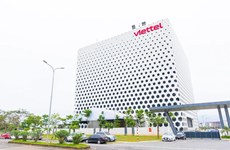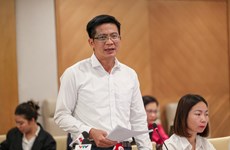Part 3: Strategy for Science, Technology and Innovation Development until 2030 approved
 Illustrative photo (Source: VNA)
Illustrative photo (Source: VNA)Hanoi (VNA) - Deputy Prime Minister Vu Duc Dam has signed Decision No. 569/QĐ-TTg dated May 11 issuing a strategy for scientific-technological development and Innovation until 2030.
Part 3: 3. Orientations for technology development and application
a) Information and communications technology
- Promoting research and wide application of information and communications technology with focus placed on cloud computing, internet of things, artificial intelligence, blockchain and virtual reality, along with the building and formation of big data as the core factor to boost digital transformation, develop digital economy, digital government and digital society, and create smart products, equipment and utilities applicable in production, services, business, social management and daily life. Mastering information safety and cyber security to ensure national security and sovereignty, interests of people and organisations, and effectively preventing cyber-attacks.
- Transferring technology and raise capacity in mastering, absorbing and promoting scientific research and technology development towards the invention of technologies for designing and manufacturing devices for telecom and mobile networks, 5G terminals and next-generation devices.
- Studying and mastering quantum and terahertz technologies.
b) Biotechnology
- With regard to health care and disease diagnosis and treatment, focusing on studying the application of gene and stem cell technologies to treat life-threatening diseases; researching and producing diagnostic biological products, vaccines and drugs for the prompt prevention and control of emerging and re-emerging human diseases; researching and developing herbal plants, producing drugs and health food meeting food safety requirements.
- In agriculture, focusing on biotechnology to create high-yield, high-quality and high-value-added crop, livestock and aquatic varieties resilient to ecological conditions and climate change impacts in Vietnam; developing biotechnology for the control and treatment of environment pollution in horticulture, husbandry and aquaculture; manufacturing vaccines, pharmaceuticals, veterinary drugs, diagnostic biologicals and those for production of animal feed, bio-pesticides, functional and microbial organic fertilisers.
- In the processing industry, focusing on research and development of biological products for food processing in an attempt to raise the added value of agricultural commodities; mastering technologies and manufacturing a comprehensive set of equipment in the bio-industry.
- With regard to environment protection, focusing on collecting and recycling by-products, treating environment pollution by biotechnology; preserving, storing and properly using rare genetic resources; and protecting biodiversity.
c) New material technology
- Transferring technology, researching and manufacturing new advanced materials for industry and construction such as functional materials with modified physical and mechanical properties, advanced polymers and composites, metal and alloy materials, protective coatings against extreme conditions, advanced technical ceramics, smart materials, new materials that are absorbent or transparent to electromagnetic waves, 3D printing materials, chemicals and materials for mechanical engineering, supporting industry and petrochemicals, recycled materials used in construction of traffic works; advanced materials for agriculture such as controlled-release fertilisers, biological pesticides, smart packaging, greenhouse materials, sensor materials for greenhouses, materials improving soil and artificial soil; biomedical materials such as implant materials, targeted drug carriers, biodegradable materials, smart composites capable of promoting cartilage and bone regeneration; biodegradable materials helping reduce environmental pollution such as biodegradable materials to replace plastics, biodegradable films; advanced materials for national defence and security such as ultra-durable, high-temperature and high-pressure resistant materials, materials for control systems; alloys with special features; electronic and photonic materials in modules and equipment of telecommunications, electrical engineering and energy-saving systems, especially optical fiber materials.
- Researching and mastering technologies of energy storage and conversion materials such as batteries, high-performance fuel cells, hydrogen storage materials, photoelectric, thermoelectric, photothermal conversion materials, wind power materials, and biofuel.
d) Technology of machine manufacturing and automation
- Acquiring, mastering and developing advanced and smart manufacturing-automation technologies, including technology of designing and manufacturing synchronised equipment and production lines in petroleum, hydroelectricity and thermoelectricity, shipbuilding, mineral exploitation and processing; technology of manufacturing energy-saving equipment systems; technology for manufacturing complex, large-scale and highly reliable systems; advanced 3D printing, reverse engineering and rapid prototyping technology used in manufacturing all kinds of industrial equipment, electric equipment, metal products and high-grade composites; Automation technology for processing and measuring information, automatic control of production processes; technology for manufacturing microcontroller chips, important high-power semiconductor components used in automation devices; technology of manufacturing basic auxiliary equipment in automation, robot technology, and automatic production lines.
- Researching and manufacturing some new equipment combinations with high accuracy and integration and automation in national defence and security.
dd) Marine technology
Researching, applying and mastering advanced technology in the management and exploitation of seas, islands and oceans in service of marine economic planning and development; advanced technology in searching and exploring resources and minerals, effectively and rationally exploiting marine resources in Vietnam's waters and coastal areas on the basis of green growth, marine biodiversity and marine ecosystem conservation, ensuring harmony between conservation and development, maintaining marine natural capital; advanced technology in warning and forecasting natural disasters and marine environmental incidents, responding to climate change in the waters and coastal areas of Vietnam.
e) Technology in natural disaster prevention and climate change response
Researching, applying, and mastering technology in forecasting impacts of climate change on natural and social systems, technology in reducing greenhouse gas emissions, technology in identifying, forecasting and warning types of natural disasters, especially dangerous ones in high-risk areas.
g) Energy technology
- Researching, applying, and mastering new energy, renewable energy and smart energy technologies, advanced energy storage technology, fuel cell. Developing and applying advanced technologies in underground coal mining, oil and gas exploitation technology in deep water and offshore areas, and liquefied natural gas (LNG) thermal power technology.
- Researching and applying atomic energy, nuclear and radiological technology in socio-economic sectors and fields; solutions to ensure radiation safety and nuclear safety, especially in healthcare, agriculture, industry and the environment.
h) Environmental technology
Promoting the application and mastering of clean production technology, environmentally friendly technology, wastewater, solid waste, hazardous waste and exhaust gas treatment technology, waste recycling technology with features and prices suitable for the conditions of Vietnam. Developing, applying and transferring advanced technology and modern equipment for waste recycling, sustainable use of resources and environmental restoration; carbon capture and storage technology in thermal power plants and other carbon-emitting production facilities.
i) Space technology
- Focused and targeted investment in several space technology fields, promoting the exploration, exploitation and use of outer space for peaceful purposes, including earth science, earth observation and supervision; space science; exploration systems; space activities and related fields.
- Strengthening the capacity of managing natural resources and the environment, supervising and assisting in reducing damage caused by natural disasters, ensuring national defence and security, and providing diverse services to the people.
- Researching, acquiring and mastering techniques and technology in designing and manufacturing a number of important equipment used in small satellites, earth stations, and terminals.
k) Advanced and smart construction, transportation and infrastructure technology
Mastering advanced techniques for foundation and erosion treatment. Researching, acquiring and mastering techniques and advanced technologies in the design and construction of infrastructure, transportation, irrigation and smart cities.
 Illustrative photo (Source: VNA)
Illustrative photo (Source: VNA)4. Orientation of innovation activities
a) Innovation in agriculture
Promoting big enterprises to invest in breeding technology, care and monitoring technology in accordance with safety and traceability standards, preservation technology, and processing technology; focusing on investment in hi-tech agricultural zones, large-scale projects, the implementation of advanced and effective cultivation models in accordance with international standards; developing new techniques for business into small and medium-sized enterprises in agriculture, forestry and fisheries.
Focusing on mastering important technology combinations for breeding through self-research, development as well as exploitation of seed banks, purchase of seeds from foreign countries in order to decipher and master the technology. Focusing on the application of biotechnology, information and communication technology and automation technology to build a smart, safe, circular, efficient and sustainable agriculture, promoting the advantages of a tropical agriculture.
Forming agricultural innovation systems associated with agricultural economic models, production chains, value chains and products with high economic values, actively contributing to linkages between the development of agriculture, the building of new-style rural areas and the improvement of the mental and physical lives of farmers.
b) Innovation in industry, construction and transportation
Implementing the restructuring process with the orientation of taking science, technology and innovation one of the breakthrough solutions, especially in the context of the Fourth Industrial Revolution. Continuing to attract big-sized enterprises’ investment in innovation, absorption and mastery of technologies, particularly smart production and manufacturing technology, innovation of management and business models, and innovation of products, which serve as the core and help create linkages and networks for promoting innovation in small- and medium-sized enterprises.
Facilitating innovation of lines, equipment, machinery and technologies, providing training in technology governance and exploitation capacity, along with applying new business models and innovation models that have been proved successful to small- and medium-sized enterprises.
Forming innovation systems associated with industrial clusters, domestic and global value chains in industries with big revenues and high export value such as textile-garment, leather-footwear, electronics, equipment and machinery, timber processing, agricultural product processing, mining, and pharmaceuticals, so as to improve productivity, quality and competitiveness of Vietnamese products, services and brands.
Focusing on promoting innovation in platform and spearhead industries such as energy industry, mechanical engineering, metallurgy, chemicals, fertilisers, materials, information and communications technology, electronics-telecommunications industry, robotics and automobile manufacturing industry, integrated equipment for automatic operation, remote control, and software industry.
c) Innovation in the service sector
Applying widely and intensively technology platforms of the Fourth Industrial Revolution and new business models in services, business and public service activities. Building standards, legal frameworks, mechanisms and policies for facilitating the development of digital platform-based enterprises and those applying digital technologies and services.
Supporting training in technology management and governance, updating new technology, and consulting the selection of appropriate technology, supporting training in operation and application of technology in production and business activities. Assisting enterprises in connection and shared use of infrastructure facilities and sharing of data to optimise technology platform-based business models.
d) Innovation in regions
Promoting innovation activities in key regions based on their respective advantages, in which the Red River Delta and southeastern regions are linked to industrial and hi-tech industrial parks; the northern midland and mountainous region is associated with clean agricultural products and tourism; the north central and central coastal region is associated with agriculture and sea-based economy; the Central Highlands region is associated with agro-forestry products, processing of agro-forestry products, and tourism; and the Mekong Delta region is associated with agricultural production, development of agricultural product processing, seed centres and technology transfer. Intensifying research into cultures, religions and humans, and solutions in response to climate change associated with characteristics of regions and localities.
Setting up an innovation system associated with value chains, sectoral connectivity clusters, and innovative start-up ecosystems in regions and localities which have adequate necessary conditions in terms of human resources for innovation, training institutions, research institutes, and material and technical facilities in association with economic advantages of regions and localities.
(to be continued)













